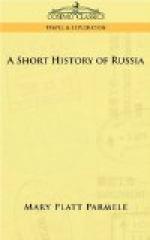Moscow, by its natural position, was the distributing center of Russian products. The wood from the North, the corn from the fertile lands, and the food from the cattle region all poured into her lap, making her the commercial as well as the spiritual and political center. Now there flowed to that favored city another enriching stream. Following in the train of Ivan’s Greek wife, were scholars, statesmen, diplomatists, artists. A host of Greek emigrants fleeing from the Turks, took refuge in Moscow, bringing with them books, manuscripts, and priceless treasures rescued from the ruined Empire. If this was a period of Renaissance for Western Europe, was it not rather a Naissance for Russia? What must have been the Russian people when her princes were still only barbarians? If Ivan valued these things, it was because they had been worn by Byzantium, and to him they symbolized power. There was plenty of rough work for him to do yet. There were Novgorod and her sister-republic Pskof to be wiped out, and Sweden and the Livonian Order on his borders to be looked after, Bulgaria and other lands to be absorbed, and last and most important of all, the Mongol yoke to be broken. And while he was planning for these he had little time for Greek manuscripts; he was introducing the knout,[1] until then a stranger to his Slavonic people; he was having Princes and boyars and even ecclesiastics whipped and tortured and mutilated; and, it is said, roasted alive two Polish gentlemen in an iron cage, for conspiracy. We hear that women fainted at his glance, and boyars trembled while he slept; that instead of “Ivan the Great” he would be known as “Ivan the Terrible,” had not his grandson Ivan IV. so far outshone him. That he had his softer moods we know. For he loved his Greek wife, and shed tears copiously over his brother’s death, even while he was appropriating all the territory which had belonged to him. And so great was his grief over the death of his only son, that he ordered the physicians who had attended him to be publicly beheaded!
The art of healing seems to have been a dangerous calling at that time. A learned German physician, named Anthony, in whom Ivan placed much confidence, was sent by him to attend a Tatar Prince who was a visitor at his court. When the Prince died after taking a decoction of herbs prepared by the physician, Ivan gave him up to the Tatar relatives of the deceased, to do with him as they liked. They took him down to the river Moskwa under the bridge, where they cut him in pieces like a sheep.




